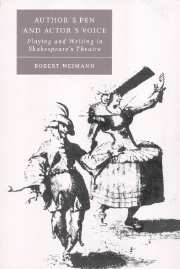Book contents
- Frontmatter
- Contents
- Preface
- Introduction: conjunctures and concepts
- 1 Performance and authority in Hamlet (1603)
- 2 A new agenda for authority
- 3 Pen and voice: versions of doubleness
- 4 Playing with a difference
- 5 Histories in Elizabethan performance
- 6 Hamlet and the purposes of playing
- 7 Space (in)dividable: locus and platea revisited
- 8 Shakespeare's endings: commodious thresholds
- Afterword: thresholds forever after
- Notes
- List of works cited
- Index
8 - Shakespeare's endings: commodious thresholds
Published online by Cambridge University Press: 22 September 2009
- Frontmatter
- Contents
- Preface
- Introduction: conjunctures and concepts
- 1 Performance and authority in Hamlet (1603)
- 2 A new agenda for authority
- 3 Pen and voice: versions of doubleness
- 4 Playing with a difference
- 5 Histories in Elizabethan performance
- 6 Hamlet and the purposes of playing
- 7 Space (in)dividable: locus and platea revisited
- 8 Shakespeare's endings: commodious thresholds
- Afterword: thresholds forever after
- Notes
- List of works cited
- Index
Summary
Divided in its formative socio-cultural impulses, contrarious in its purposes of playing, unstable in the symbolism of its spatial conventions, the Elizabethan theatre harbored a pervasive need to digest the (ab)use of the distance between the world-in-the-play and the playing-in-the-world of early modern amphitheatrical scaffolds. To a certain extent, the “swift” and “swelling scene,” the platform stage itself was commodious enough to accommodate, even thrive upon the social, cultural, spatial, and verbal differences in question. But when the performed play began and, even more so, when it came to an ending, the impromptu, pragmatic, and vulnerable interface between symbolic forms and material stages was most irrevocably in question. At this point, any sense of equivalence or any achieved form of contrariety between them must have found itself in a state of crisis. There must have been uncertainty about the untried, unfixed order of this interface, first of all in the process of the play's commencement, introduction, and unfolding. But there was an even greater incertitude in the phase of dissolution, when after a mere two or three hours' business, it was time to “untie the spell” (The Tempest 5.1.253) of this conjunction, to surrender unconditionally the world-in-the-play with its “so potent art” (50) to the circumstances of everyday existence.
- Type
- Chapter
- Information
- Author's Pen and Actor's VoicePlaying and Writing in Shakespeare's Theatre, pp. 216 - 245Publisher: Cambridge University PressPrint publication year: 2000
- 1
- Cited by



